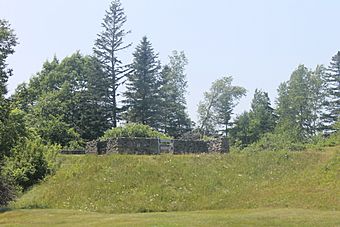Castine Historic District facts for kids
Quick facts for kids |
|
|
Castine Historic District
|
|

Ruins of the British-built Fort George (1779)
|
|
| Lua error in Module:Location_map at line 420: attempt to index field 'wikibase' (a nil value). | |
| Location | Roughly bounded by Bagaduce and Penobscot Rivers, and Wadsworth Cove Rd., Castine, Maine |
|---|---|
| Area | 1,800 acres (730 ha) |
| Architectural style | Greek Revival, Federal |
| NRHP reference No. | 73000240 |
| Added to NRHP | February 23, 1973 |
The Castine Historic District is a special area in Castine, Maine. It covers the southern tip of the peninsula where the town is located. This district is about 1,800 acres (730 ha) in size. It was very important during colonial times, starting in the early 1600s. Many battles happened here during the American Revolutionary War and the War of 1812. Because railroads didn't come through Castine, the area still feels like a small village from the early 1800s. It was added to the National Register of Historic Places in 1973.
Castine's Rich History
Castine is located where the Bagaduce River meets Penobscot Bay. This is in the middle of Maine's coast. Long ago, this area was known by other names like "Pentagoet."
Early Days and Conflicts
In the early 1600s, the French set up a trading post here. English colonists didn't like this. Around 1630, the Plymouth Colony took control of the area. Castine changed hands many times in the 1600s. By the 1670s, it was firmly under French control. This was thanks to Jean-Vincent d'Abbadie de Saint-Castin. The town of Castine is named after him.
After the French leader's son was captured in 1725, the French left the settlement. British colonists from the Province of Massachusetts Bay then settled there in 1760.
Wars and Changes
Castine became a battleground again during the American Revolutionary War. British forces took over the peninsula in 1779. They built forts to protect it. Massachusetts sent a large military force to fight them. This led to the terrible Penobscot Expedition. The entire Massachusetts fleet was destroyed. Many ships were sunk in the Castine area.
British forces also occupied Castine in 1814. This happened during the War of 1812.
After the War of 1812, Castine's economy grew. It became a busy port for ships. Many beautiful buildings were constructed during this time. These buildings were in the Federal style.
Later, railroads became the main way to travel and move goods. Sailing ships were replaced by steamboats. Castine was far from the new railroads. This caused its economy to slow down. However, a normal school (a college for training teachers) helped the town. In 1942, the Maine Maritime Academy took over the school's campus.
A Look at the Buildings
The buildings in Castine are mostly from before 1860. They are in styles like Georgian, Federal, and Greek Revival. There are also a few Victorian summer homes built later.
You can still see parts of the old British and American forts. These are important historical sites. The Dice Head Light is also a key landmark. This lighthouse was built in 1829. It stands at the southwestern tip of the peninsula.

